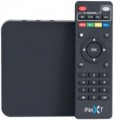Miracast
A wireless technology that allows you to directly broadcast video and audio from one device to another directly over a Wi-Fi connection. At the same time, unlike AirPlay, transmission does not require a router and building a local network — it is enough that the receiver and transmitter are compatible with Miracast. One of the most popular ways to use this technology is to output a “picture” from a smartphone / tablet screen to a TV, and vice versa.
A media centre or TV receiver with Miracast is useful if the TV itself does not support this function.
Audio decoders
The set of audio codecs supported by the device
Codec — from the phrase "Encoder-DEcoder" — in this case, the format used for encoding and compressing sound in digital form during storage/transmission and decoding — during playback (digital sound is basically impossible without encoding, and compression allows to reduce the amount of data). Information about supported codecs is relevant primarily for assessing whether the player will be able to work with sound in a particular video file. The fact is that even in video files of the same format (see below), sound can be compressed by different codecs; and if the player supports the file format, but does not support the codec, sound playback will become impossible.
Theoretically, these rules are also relevant for audio files and online broadcasts (all formats — TV, video, audio). However, in fact, when working with such content, you can ignore codec data. So, for each audio file format, usually, its own standard codec is used, and file type support automatically means codec support. Broadcasts usually use generally accepted audio decoders like MPEG-1 or MPEG-2, which are practically guaranteed to be supported by any modern player designed for such broadcasts.
As for specific codecs, detailed information on them can be found in special sources, however, with the standard use of devices, such details are usually not needed.

